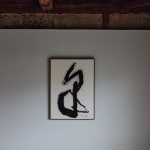Morita Shiryū (1912–1998)
Izumi
Ink on paper, framed
c. 1975
With a label signed by Inada Sousai
95 x 69 cm
97 x 71 cm (overall)
c. 1975
With a label signed by Inada Sousai
95 x 69 cm
97 x 71 cm (overall)
Literature
Morita Shiryu Catalogue Raisonné: 1952–1998. Uji: Soryusha, 2019.
After participating in the Seventh Japan Art Festival that was touring Central and South America in 1972, Morita remained silent for almost two years. During this period, he started the Izumi series, which eventually peaked in 1975. He debuted the series in the same year at Asahi Gallery, Kyoto. The works shown in this exhibition indicated that Morita now tried to refrain from actively pursuing the movement of the brushstrokes or exploring his materials as he did in the early 1960s. Instead, he thought to follow a more natural flow, moving his body accordingly.
Morita’s avant-garde calligraphy has been criticized as bound for failure due to his seemingly limited vision of calligraphy—calligraphy as a display of a sequence of movements, taking too lightly its role as means of communication and the transmission of thoughts and ideas. Morita had pursued an expansion of the manifold possibilities of sho, for instance when in the 1950s he tried to “dissolve” the character, in the 1960s he explored new materials and techniques, in addition to the expansion of the meditative character of his art. From this point of view, calligraphy’s role as a vehicle of intellectual thought and discourse was a whole other dimension. Morita was quite aware of these issues. In the 1970s, even after he had stopped introducing new techniques, he focused on his inner dialog with nature, thus once more opening up new territory in his art making. This Izumi series and the 1975 solo exhibition at Asahi Gallery exemplified Morita just reaching another prime in his artistic career.
Morita Shiryu (avant-garde calligrapher; 1912–1998)
Avant-garde calligrapher from Hyogo Prefecture. Like fellow artist Inoue Yuichi, Morita studied under the calligraphy master Ueda Sokyu. He co-founded the avant-garde group Bokujinkai together with Inoue and was the founder and editor of the journal Bokubi (Beauty of Ink), both of which revolutionized traditional Japanese calligraphy and spread knowledge of Japanese avant-garde calligraphy to an international audience. He was posthumously awarded the Medal of Honor with Dark Blue Ribbon.
Morita’s avant-garde calligraphy has been criticized as bound for failure due to his seemingly limited vision of calligraphy—calligraphy as a display of a sequence of movements, taking too lightly its role as means of communication and the transmission of thoughts and ideas. Morita had pursued an expansion of the manifold possibilities of sho, for instance when in the 1950s he tried to “dissolve” the character, in the 1960s he explored new materials and techniques, in addition to the expansion of the meditative character of his art. From this point of view, calligraphy’s role as a vehicle of intellectual thought and discourse was a whole other dimension. Morita was quite aware of these issues. In the 1970s, even after he had stopped introducing new techniques, he focused on his inner dialog with nature, thus once more opening up new territory in his art making. This Izumi series and the 1975 solo exhibition at Asahi Gallery exemplified Morita just reaching another prime in his artistic career.
Morita Shiryu (avant-garde calligrapher; 1912–1998)
Avant-garde calligrapher from Hyogo Prefecture. Like fellow artist Inoue Yuichi, Morita studied under the calligraphy master Ueda Sokyu. He co-founded the avant-garde group Bokujinkai together with Inoue and was the founder and editor of the journal Bokubi (Beauty of Ink), both of which revolutionized traditional Japanese calligraphy and spread knowledge of Japanese avant-garde calligraphy to an international audience. He was posthumously awarded the Medal of Honor with Dark Blue Ribbon.



